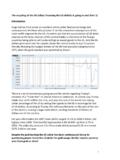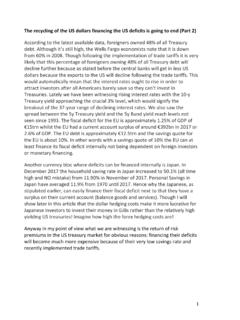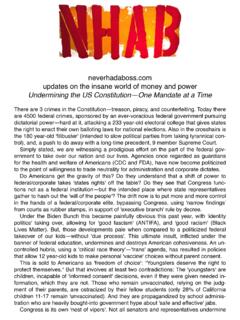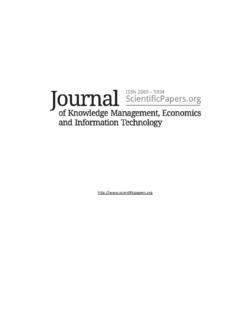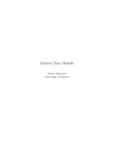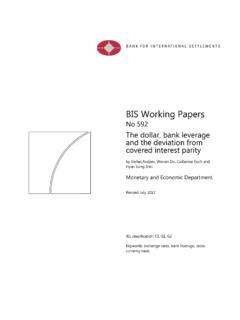Transcription of The recycling of the US dollars financing the US …
1 The recycling of the US dollars financing the US deficits is going to end (Part 3) Conclusion why the US dollar's reserve status is at risk What is at stake is the reserve status of US dollar following: 1. Loss of dependency on Saudi oil because of the US becoming an oil net importer as early as 2019 making the Petro-Dollar contract less of importance. 2. The introduction of the Petro-Yuan-Gold contract planned for March 26. 3. Trade tariffs that will reduce the flow of US dollars into foreign central banks and as such the recycling of US dollars into financing US deficits. 4. The increasing budget and trade deficits that need financing from foreign investors (good for 48% of treasuries ownership), because Americans don't save with a savings quote of , and demanding higher interest rates.
2 Also because the increasing US dollar hedging costs. 5. The blowing out of the Libor-OIS spread, the global yardstick for cost of credit and uncertainty, risk in the global credit markets. 6. Accelerating inflation, looming higher interest rates and the exhaustion/tapering of the QE measures that will not miss their impact on the tightening credit conditions resulting in the debasement of the currencies and especially the reserve currency. Ad 5 - I discussed points 1 to 4 and will discuss point 5 next. Why are people worried with respect to the increasing Libor-OIS? The Libor rate for three-month loans in dollars has climbed to , a level it hasn't reached since 2008. 1 Next to that the spread over the OIS rate or Overnight Index Swap rate (or Fed's Fund Rate), has also widened quite dramatically following a Congressional deal on the budget and debt ceiling on Feb.
3 8, one of the most closely followed leading indicators of an imminent funding crisis and global credit crunch, broke above its 6 year range, when the USD Libor-OIS spread on Friday March 16, rose to And in my point of view this time it is not offshore causes, like Brexit or the Greek Bailout, that triggered the spread to blow out but onshore causes such as the increasing difficulty to finance the US deficits. Next to that I want to emphasize that it is especially the speed of the move that is giving some investors pause for thought. Remember it is always the rate of change that worries investors because of the inability to adapt to the new situation. Defining the two rates, Libor (officially known as ICE (InterContinental Exchange) Libor since February 2014) is the average interest rate that banks charge each other for short term, unsecured loans.
4 The rate for different lending durations from overnight to one-year are published daily. The interest charges on many mortgages, student loans, credit cards and other financial products are tied to one of these Libor rates. In fact, over $350 trillion dollars ' worth of financial derivative contracts, mortgages, bonds and retail and commercial loans have their interest rates tied to Libor. Libor is designed to provide banks around the world with an accurate picture of how much it costs to borrow short term. Each day, several of the world's leading banks (thus not only US banks!!!) report what it would cost them to borrow from other lenders on the London interbank market. Libor is the average of these responses.
5 Libor also indicates how much trust there is in the banking system, between the US and Row, because these Libor rates will rise when banks don't trust the creditworthiness of their counter-party banks anymore. Though it should be noted that there has been an initiative to replace Libor with the repo rates. I wonder why? I am facetious of course because it is all about control! An industry body, the Alternative Reference Rates Committee or ARRC, convened by the US government, has chosen a new benchmark interest rate to replace the scandal-ridden Libor gauge as a reference for trillions of dollars of financial instruments. The decision brings to a head efforts to establish a new reference interest rate after Libor became tarnished by revelations of widespread rigging by the banks that set it, as traders sought to manipulate it to their benefit.
6 And where do you think most of that rigging took place and what makes you think that won't happen with the repo rate? Despite reforms to Libor, the ARRC took the decision to move away from the rate, as the market for 2 unsecured transactions between banks has dwindled, recommending a brand- new, broad Treasuries repo rate, which will reflect the cost of borrowing cash secured against US government debt, as a replacement for the US dollar Libor rate. The new rate will be based on live, actual transactions and published by the Federal Reserve Bank of New York in co-ordination with the Office of Financial Research, in an attempt to reduce the risk of manipulation. This is in my point of view purely done in order to bring these benchmarks for credit purely under control of the Americans thereby reducing the influence of foreign banks.
7 It is one big scam! Remember the more you control the less you are in control! The OIS, meanwhile, represents a given country's central bank rate over the course of certain period; in the , that's the Fed Funds rate the key interest rate controlled and fixed by the Federal Reserve currently ranging between and most likely to be increased by on Wednesday. The OIS is derived from the overnight rate, which is typically a fixed rate by central banks. As a result, the OIS lets LIBOR banks borrow at a fixed rate over a specified time. If a commercial bank or a corporation wants to convert from variable interest to fixed interest payments or vice versa it could swap interest obligations with a counterparty.
8 For example, a entity may decide to exchange a floating rate, the Fed Funds Effective Rate, for a fixed one, the OIS rate. It should be emphasized that in the last 10 years, with interest rates at historical lows, there's been a marked shift toward OIS fixed rates for certain derivative transactions. Because the parties in a basic interest rate swap don't exchange principal, but rather the difference of the two interest streams, credit risk isn't a major factor in determining the OIS rate. During normal economic times, it's not a major influence on LIBOR, either. But we know that this dynamic changes during times of turmoil, when different lenders begin to worry about each other's solvency.
9 In the end it becomes about the return of your money and not the return on your money! Prior to the subprime mortgage crisis in 2007 and 2008, the spread between the two rates was as little as points. At the height of the crisis, the gap jumped as high as 3 So why does it matter that the Libor-OIS spread is widening! Short-term borrowing costs in the have risen to levels unseen since the 2008 financial crisis, and recent moves in two closely watched indicators -- the London interbank offered rate and its spread with the Overnight Index Swap (OIS) rate -- are causing some consternation. The spread has expanded to its widest level in more than a year, raising questions about whether risks might be brewing within credit markets.
10 The spread surpassing the 2011/2012 highs (and the widest level since May 2009), when the latest European sovereign debt crisis was roiling the markets and forced the Fed to open unlimited swap lines with the rest of the world to avoid a global dollar funding crisis and effectively bail out the world, which according to the BIS is synthetically short the USD to the tune of over $10 trillion - for the second time in 4 years. Whatever the cause of the ongoing blow out in Libor-OIS, this move is having defined, and adverse, consequences on both dollar funding and hedging costs. This alone will have a severe impact on foreign banks, because as Deutsche Bank wrote recently, "the rise in dollar funding costs will damage the profitability of hedged investing and lending by [foreign] financial institutions.

